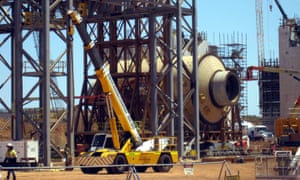Exclusive: Nearly 60 industrial sites get green light to increase emissions, cancelling out cuts paid for by Coalition using public money
The increases have been quietly approved under the “safeguard mechanism”, which was introduced as part of Direct Action to ensure cuts paid for using the main part of the policy – the emission reduction fund – were not undone by emissions increasing in other parts of the economy.
Under the safeguard mechanism, government agency the Clean Energy Regulator sets an emissions limit for each large industrial site based on its highest level of emissions over the previous five years. But companies can apply to have the limit recalculated.
The regulator has signed contracts worth $2.25bn under the emissions fund, mostly with businesses that plan to plant trees and repair degraded habitat over the next decade. The idea is the vegetation will store carbon dioxide drawn from the atmosphere.
But an analysis of data on the regulator’s website by consultants RepuTex Carbon found the regulator had simultaneously allowed 57 industrial sites to increase emissions above their previous highest level.
Based on the average price paid by the government – $11.90 per tonne of carbon dioxide – it would effectively cancel out up to $261.8m of emissions cuts a year.
"Emissions growth is outpacing the abatement from the emissions reduction fund, so what has been the point?"
This has prompted fresh accusations that Direct Action is doing little to curtail Australia’s emissions, which were already rising before a round of 44 industrial facilities had their emissions increases approved on 25 January.
The RepuTex executive director, Hugh Grossman, said it showed the safeguard mechanism was ineffective.
“It’s a safeguard in name only. There is no doubt emissions growth is outpacing the abatement from the emissions reduction fund, so what has been the point?” he said.
RepuTex found that by 2030, emissions from large industrial sites were projected to be 30% higher than in 2005, and 16% higher than when the safeguard mechanism was announced four years ago.
They are expected to grow to be the biggest source of Australia’s emissions, surpassing those from burning coal and gas for electricity.
The biggest increases allowed under the safeguard mechanism have been for coalmining operations, including Whitehaven’s Maules Creek open cut mine in New South Wales, BM Alliance’s Broadmeadow mine in Queensland and Citic Pacific’s Sino Iron project in the Pilbara. Liquefied natural gas plants such as the projects of Chevron at Gorgon and Santos at Curtis Island have opened with approved emissions limits that are not offset elsewhere.
Grossman said the industrial sector now posed a larger problem than electricity emissions, which had started to decline, though not quickly enough.
“It’s black and white – if industrial emissions are not resolved, we won’t meet our Paris commitments,” he said.
Under the 2015 Paris deal, Australia pledged to cut emissions by between 26% and 28% below 2005 levels by 2030.
The growth in industrial emissions suggests deeper cuts would be needed in other parts of the economy for that commitment to be met. But the government is not proposing deeper cuts in the electricity sector, currently the biggest emissions source. Under the national energy guarantee, it proposes to cut pollution from generators by 26% and is considering allowing electricity retailers to defer some cuts.
It is also considering making the safeguard mechanism less stringent. A Turnbull government climate policy review released in December suggested emissions limits could be loosened so they “increase with production, supporting business growth”.
The environment and energy minister, Josh Frydenberg, said the safeguard mechanism was operating in accordance with legislation, rules and regulations.
A spokeswoman for the Clean Energy Regulator said they included allowing reappraisal of how much a facility could emit if there was not enough historic data over the previous five years, or if the data did not accurately represent activity at the industrial site now. She said the safeguard mechanism was meant to make sure cuts paid for using the emissions reduction fund were not offset by “significant increases above business-as-usual levels”, but also to accommodate economic growth.
The Australian National University economist Paul Burke said the safeguard mechanism had been designed to be loose and flexible. “It is a complicated and inefficient way to approach the goal of reducing emissions,” he said.
Frydenberg said the mechanism was part of a suite of policies, including the successful emissions reduction fund, the renewable energy target and a national energy productivity plan, the details of which are yet to be released. He said contracts had been signed to cut emissions by 191m tonnes over the coming years, and the Climate Change Authority, a government agency, had found the fund was performing well.
The minister said Australia was on track to comfortably beat its 2020 target of a 5% cut below 2000 levels. He did not mention the 2030 target.
Environment department data released in December showed national emissions have increased each year since 2014, when the carbon price scheme that put a charge on greenhouse pollution was repealed. They rose 0.7% last financial year.
The department projects its current trajectory emissions will be about 2% higher in 2030 than in 2005.
RepuTex projects Australia will also fall short of its 2020 target of a 5% cut in absolute terms, with emissions expected to be at the same level as in 2000. But the country will meet its target under United Nations greenhouse accounting rules by using credits carried over from the previous target period, when Australia’s target was an 8% emissions increase between 1990 and 2012.

No comments:
Post a Comment